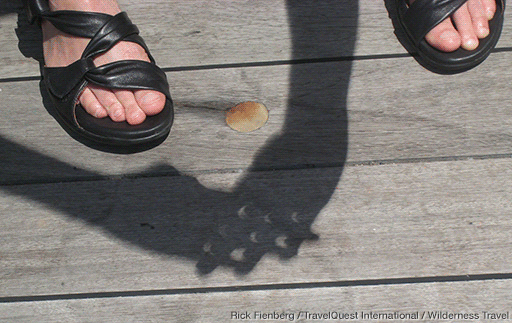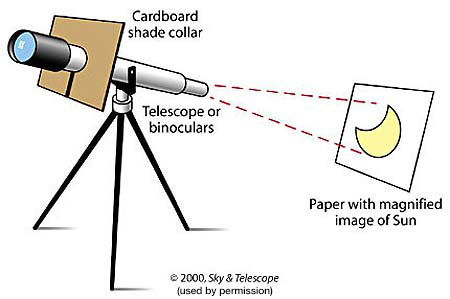COUNTDOWN TO TOTALITY* 22.07.28
Day(s)
:
Hour(s)
:
Minute(s)
:
Second(s)
Projection – Pinhole & Optical
Pinhole
As noted in the section How to View a Solar Eclipse Safely, a convenient method for safe viewing of the partially eclipsed Sun is pinhole projection.
You simply pass sunlight through a small opening (for example, a hole punched in an index card) and project an image of the Sun onto a nearby surface (for example, another card, a wall, or the ground).
You don’t need any special equipment to do this! Just cross the outstretched, slightly open fingers of one hand over the outstretched, slightly open fingers of the other.
Then, with your back to the Sun, look at your hands’ shadow on the ground. The little spaces between your fingers will project a grid of small images on the ground.
During the partial phases of the solar eclipse, these images will reveal the Sun’s crescent shape, as shown in the accompanying photo.
If your observing site has trees, look at the shadows of leaves on the ground. During the partial solar eclipse, the tiny spaces between the leaves will act as pinhole projectors, dappling the ground with images of the crescent Sun!
Note that pinhole projection does not mean looking at the Sun through a pinhole!
You project sunlight through the hole onto a surface and look at the solar image on the surface.
Note too that pinhole projection is not useful for observing the total phase of a total solar eclipse; the projected image would be too faint to see.
During totality, when it suddenly gets very dark, it is perfectly safe to look directly at the eclipsed Sun.
Optical
You can also use a telescope or binoculars to project images of the partially eclipsed Sun onto a surface for convenient viewing.
This is called optical projection, because it involves optics (that is, lenses and/or mirrors). Compared with pinhole projection, optical projection generally provides bigger, brighter, sharper images.
You should not attempt optical projection unless you are an experienced astronomical observer, are using your own equipment, and can remain with your equipment at all times to supervise its use.
This is because passing bright sunlight through binoculars or a telescope can damage the device, and because of the danger that someone might look at the Sun through the device and injure their eyes.


